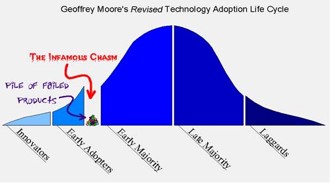Geoffrey Moore’s seminal concept, Crossing the Chasm, is enduring and invaluable in understanding how customer adoption transpires and many products get caught in the proverbial chasm.
In Crossing the Chasm: Marketing and Selling High-Tech Products to Mainstream Customers, Geoffrey Moore defines the Technology Adoption Life Cycle. This is the evolution of innovation as it moves from the fringes to the mainstream in four stages:
Crossing the Chasm – The four stages of adoption
1. Early Adopters
In the Early Market, buyers are classified as early adopted. They are willing to take the risk on unproven technology in exchange for being ahead of others.
2. Early Majority
Buyers are pragmatic and wait until there’s herd adoption. Once the technology has been proven and accepted, it forces action to avoid being left behind.
3. Late Majority
In the Late Majority, buyers shift to maintaining their investment in technology that is adopted broadly. They start looking for better value and lower cost of ownership.
4. Laggards
For personal or economic reasons, they are not necessarily in the market for the product or only adopt it as a last resort.
You see the four stages as they span the lifecycle of a product from innovation to early adopters, early majority, late majority, and the laggards.

Crossing the Chasm
Moore calls the gap where the chasm occurs as buyers that are “pragmatists in pain.” They may be stuck with a business problem and may be willing to take a risk with something new if it is solely focused on their specific use case. This gap between the visionaries and enthusiasts in the Early Adopter stage and the Early Majority can be significant.
The chasm, according to Moore, can be a difficult place for companies. Growth might have stalled, revenue might be stagnant, and you’re trying to find another pathway but nothing seems to work. What got you where you are no longer appears the way to continue that growth. Crossing the Chasm takes a different approach.
Early Adopters and the more pragmatic Early Majority have different needs and expectations, it takes a concerted strategy to move products from one phase to another.
- Choose a target market
- Use a whole product concept
- Position the product
- Select the distribution
- Proper pricing
Target Market
Moore talks about storming the beaches on D-Day and how the Allies chose to focus efforts at Normandy to cross the chasm between England the rest of Europe. In the early stages, it’s necessary to focus significant efforts again specific targets.
It can be difficult to attract the attention of the majority of companies when you’re working with an unknown or unproven product. However, if you can find the right target that has a problem they need to solve, you may be able to ease their pain. If it works, they won’t care whether you’ve proven your model works for anyone else – as long as it works for them.
The key, Moore says, is to find a customer segment that’s small enough to be ignored by others but big enough to matter to you.
Whole Product Concept
Just as the Allies chose to ignore other places of conflict in WWII to dominate the beaches at Normandy, companies should focus their product to provide a solution to a problem better than anyone else. To cross the chasm, this goes well beyond the product itself.
For early-stage technology, this often manifests itself as an MVP approach. A Minimally Viable Product is launched to gather feedback for refinement to grow into the whole product mindset. This concept can be a different way to look at an innovation or creating the entire eco-system to support everything about your product, such as Apple did when it created iTunes to support its mobile operating system and music libraries.
Position the Product
Apple also famously crossed the chasm with whole product thinking when it introduced the iPod. It wasn’t just a device to store and play music, it was a way to take your entire music library with you wherever you wanted to go. It was a huge leap from CDs with limited space and moved the product from early adoption to mainstream.
Positioning either has to create a resounding reason for purchase or create a significant ROI for the user.
Distribution
Moore contends that most distribution channels are made up to two categories:
- Demand Creation
- Demand Fulfillment
A direct sales channel is optimized for demand creation. Unless the product category is well established, it will take marketing and explaining the benefits. Conversely, retail sales channels are more about demand fulfillment. When a product category is established, the benefits are more obvious to customers. There’s already existing demand.
Proper Pricing
Pricing is always tricky, especially for new market entrants or new products. Moore recommends pricing the product relative to competitive comparisons rather than value-based pricing tactics. If you try to put a price point that is far less than competitors to grow market share, buyers may assume it’s sub-standard.
Mass Adoption
It’s only when these five strategies are executed that products can cross the chasm to larger adoption.
Other Classic Frameworks:
If you liked Crossing the Chasm by Geoffrey Moore, please read about other classic frameworks by other famous authors and management thinkers.

